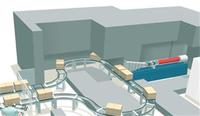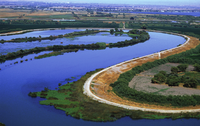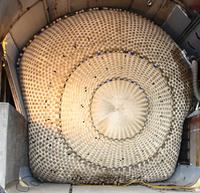-
Miniature sensors to advance climate studies, battlefield detection
Self-sealing valves are not only better for collecting reliable climate information – they also increase data reliability for airborne industrial and battlefield gas detection and point-of-contact medicine
-
-
Growing Asia Pacific research strengths leaving U.S.-based research behind
The publications output of Chinese scientists is set to surpass that of U.S.-based scientists by 2013; in the meantime, major investments in discovery and innovation are building capacity in Korea, Singapore, and Taiwan
-
-
Raytheon highlights Mathematics Awareness Month activities
The importance of science, technology, engineering, and math (STEM) education to U.S. economic well-being and national security cannot be overemphasized; Raytheon is famous for its commitment to STEM education, and this month — Mathematics Awareness Month — the company highlights the many STEM-related activities it sponsors
-
-
E-beam technology to keep food supply safe

More than two million people a year, most of them children, die from food-borne or water-borne illness; more than one-third, or 1.3 billion tons, of the food produced for human consumption every year is wasted or lost because of spoilage; the UN nuclear weapons watch dog, the IAEA, says that irradiating food is a more effective solution for preventing death, illness, and food spoilage than techniques currently in use: heating, refrigerating, freezing, or chemical treatment
-
-
New technology sheds light on viruses
Scientists develop diagnostic tests that rapidly detect disease-causing viruses in animals and humans; the scientists using a new technology called surface-enhanced Raman scattering, or SERS
-
-
Stormy weather in Europe's future
Europeis likely to be hit by more violent winter storms in the future; a new study into the effects of climate change has found out why
-
-
HPDC to publish best grid computing cybersecurity papers
In the late 1990s, as science was pushing new limits in terms of levels of computation and data and in the collaboration between scientists across universities, countries, and the globe, grid computing emerged as the model to support such large scientific collaborations by providing their computational resources and the structure behind them
-
-
2012 National Collegiate Cyber Defense Competition kicks off 20 April

The National Collegiate Cyber Defense Competition (NCCDC) is returning to the University of Texas at San Antonio (UTSA) for the seventh consecutive year; the 3-day national championship will kick off 20 April
-
-
U.S. students need new way of learning science

The United States used to lead the world in science education, but now U.S. students are ranked a mediocre 23rd in their science knowledge; a group of prominent scientists says that American students need a dramatically new approach to improve how they learn science
-
-
U.S. Navy experience shows climate alterations
The U.S. Navy reports that because of its worldwide presence, it sees the effects of climate change directly; and expert tells a scientific audience at Sandia Lab that disparities in current climate science projections “mean that the Navy should plan for a range of contingencies, given our limited ability to predict abrupt change or tipping points for potentially irreversible change”
-
-
Post-communist depression
A new study reveals how a radical economic policy devised by Western economists put former Soviet states on a road to bankruptcy and corruption
-
-
Researchers use electricity to generate alternative fuel
Scientists show that we can use electricity to power our cars — even if these cars are not electric vehicles; the researchers demonstrated a method for converting carbon dioxide into liquid fuel isobutanol using electricity
-
-
Water scarcity in California's Bay-Delta necessitates “hard decisions”

Simultaneously attaining a reliable water supply for California and protecting and rehabilitating its Bay-Delta ecosystem cannot be realized until better planning can identify how trade-offs between these two goals will be managed when water is limited
-
-
Containing a tunnel flood with an inflatable giant plug

Researchers have developed a giant plug to contain tunnel floods; the plug inflates (with water or air) to dimensions of roughly 32-feet-long and by 16-feet-wide, and holds 35,000 gallons, about the same capacity as a medium-sized backyard swimming pool
-
-
Test strip detects TNT and other explosives in water
Scientists developed a new explosives detector that can sense small amounts of TNT and other common explosives in liquids instantly with a sensitivity that rivals bomb-sniffing dogs, the current gold standard in protecting the public from terrorist bombs
-
More headlines
The long view
New Technology is Keeping the Skies Safe
DHS S&T Baggage, Cargo, and People Screening (BCP) Program develops state-of-the-art screening solutions to help secure airspace, communities, and borders
Factories First: Winning the Drone War Before It Starts
Wars are won by factories before they are won on the battlefield,Martin C. Feldmann writes, noting that the United States lacks the manufacturing depth for the coming drone age. Rectifying this situation “will take far more than procurement tweaks,” Feldmann writes. “It demands a national-level, wartime-scale industrial mobilization.”
How Artificial General Intelligence Could Affect the Rise and Fall of Nations
Visions for potential AGI futures: A new report from RAND aims to stimulate thinking among policymakers about possible impacts of the development of artificial general intelligence (AGI) on geopolitics and the world order.
Smaller Nuclear Reactors Spark Renewed Interest in a Once-Shunned Energy Source
In the past two years, half the states have taken action to promote nuclear power, from creating nuclear task forces to integrating nuclear into long-term energy plans.
Keeping the Lights on with Nuclear Waste: Radiochemistry Transforms Nuclear Waste into Strategic Materials
How UNLV radiochemistry is pioneering the future of energy in the Southwest by salvaging strategic materials from nuclear dumps –and making it safe.
Model Predicts Long-Term Effects of Nuclear Waste on Underground Disposal Systems
The simulations matched results from an underground lab experiment in Switzerland, suggesting modeling could be used to validate the safety of nuclear disposal sites.
